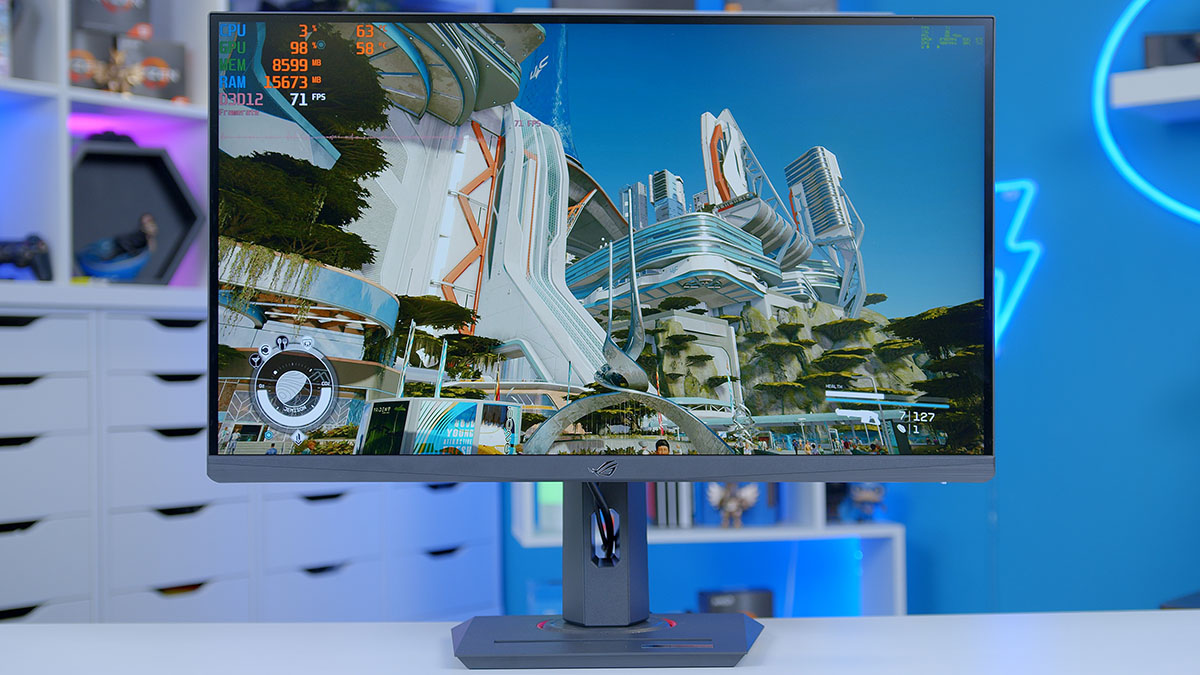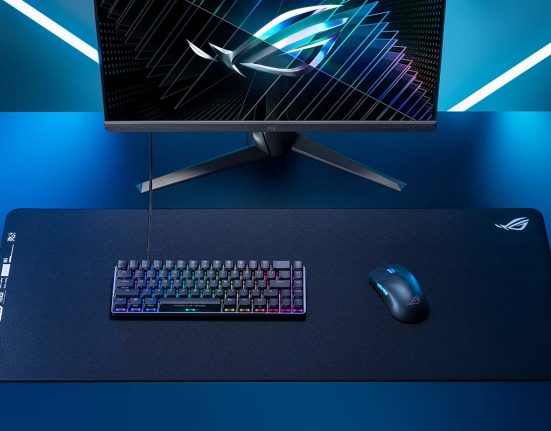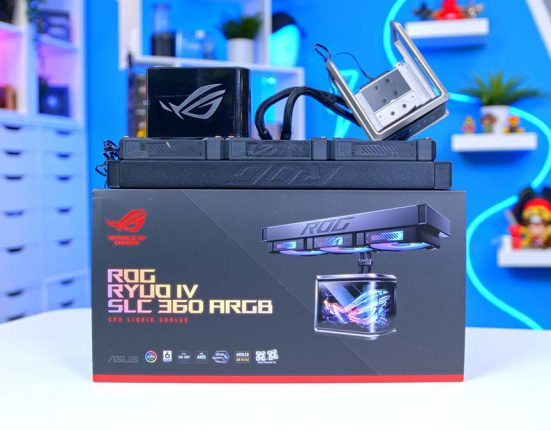The ASUS ROG Strix XG27UCG is a 4K gaming monitor with an impressive 160Hz refresh rate, allowing gamers to remain competitive when dialling up the visuals. However, this monitor is also a 1080p display with a maximum refresh rate of 320Hz. This is thanks to the dual mode capabilities on the ASUS ROG Strix XG27UCG, which make it possible to switch between the 4K 160Hz and 1080p 320Hz presets at the press of a button. In this review, we’ll test this display’s design, performance, and functionality, paying close attention to the dual mode display to determine whether it improves gameplay optimization.
When choosing a gaming monitor, one decision that often causes the biggest headache is whether you should prioritise performance or visual fidelity. Each gaming genre, and in some cases, games within the same genre, requires specific performance or visual parameters for optimal gameplay. Because of this, anyone who likes to play a wide variety of games is forced to choose if they should optimise for one game or find a middle-ground that leads to a sub-optimal experience in most titles.
However, dual-mode gaming monitors like the ASUS ROG Strix XG27UCG aim to resolve this issue by offering a flexible viewing experience. The question is, will this innovation revolutionise how we play games, or will it be nothing but a rarely used gimmick?
Specification
Unlike other gaming monitors we’ve tested, the ASUS ROG Strix XG27UCG’s base specs do not give us the full picture. Instead, we need to separate the two presets packaged into this display. Firstly, the 4K resolution mode includes a max refresh rate of 160Hz, which is pretty impressive for any 4K gaming monitor. Whilst it is possible to find 4K monitors with up to 240Hz refresh rates, most modern games won’t be able to surpass 100 FPS (frames per second), let alone 160 FPS, meaning the 160Hz on the ROG Strix XG27UCG should have no issues supporting the latest AAA titles.
The 1080p 320Hz mode will be the better option for games that benefit from higher refresh rates. By sacrificing visual quality, the ROG Strix XG27UCG can double its refresh rate, leading to buttery smooth gameplay in competitive games. Again, other 1080p gaming monitors exceed this refresh rate, with some displays boasting a whopping 500Hz. However, the performance difference will only benefit very competitive gamers and Esports players, as the uplift will be negligible to most gamers.

Apart from the refresh rate and resolution, the two preset modes on the ROG Strix XG27UCG are powered by the same technology under the hood. No matter which mode is active, this monitor features a 1ms GtG (Grey to Grey) response time, which enables quick reactions to ensure opposing players won’t have a competitive advantage. The smooth and responsive gameplay is bolstered further with support for both NVIDIA G-SYNC and AMD FreeSync, as this technology eliminates common issues such as screen tearing and ghosting.
Regarding visual fidelity, the ASUS ROG Strix XG27UCG includes several features that will benefit both presets. Obviously, the 4K 160Hz mode will lead to a much better image than its 1080p counterpart, but the Rapid IPS panel will help to enhance visual fidelity at the lower resolution. With 400 Nits peak brightness and a whopping 100 million to 1 contrast ratio, shadows and bright lights can be seen with incredible detail. In addition, the 95% DCI-P3 and complete sRGB coverage will provide a range of vibrant colours.
| Key Specs | ASUS ROG STRIX XG27UCG |
|---|---|
| Screen Size | 27″ |
| Max Resolution | 3840×2160 |
| Refresh Rate | 320Hz |
| Response Time | 1ms (GtG) |
| Colour Gamut | 100% sRGB 95% DCI-P3 |
| Peak Brightness | 400 Nits |
| Contrast Ratio | 100000000:1 |
| Panel Type | Fast IPS |
| Display Inputs | 1x DisplayPort 1.4 1x HDMI 2.1 1x USB Type-C (DP Alt Mode) |
| Additional IO | Earphone Jack |
| VRR Technology | NVIDIA G-SYNC AMD FreeSync Premium ELMB Sync |
The one weak area of this monitor appears to be connectivity, as the ROG Strix XG27UCG includes a single DisplayPort 1.4, HDMI 2.1, and USB Type-C cable. This is enough to connect a gaming PC, console, and gaming laptop, but adding a duplicate for any of these ports would provide greater versatility. Additionally, the single earphone jack means the only peripherals that can be plugged in through the monitor are speakers or gaming headsets.
Overall, having two separate viewing modes creates a unique sense of versatility for this gaming monitor. However, the ROG Strix XG27UCG is packed with plenty of features designed to enhance the visuals and performance of this display, no matter which preset is being used. However, the focus on performance and visual fidelity comes at the expense of connectivity, which is significantly limited compared to other gaming monitors.
Design
The design is arguably the least surprising aspect of the ROG Strix XG27UCG, as it shares a lot of similarities with other ASUS ROG STRIX gaming monitors that we’ve tested. For example, this monitor looks almost identical to the ROG Strix XG27ACS, an affordable 1440p display we reviewed previously. In fact, the only noticeable difference is the RGB lighting on the back of the ROG Strix XG27UCG.
Given my thoughts on the ROG Strix XG27ACS’ design, it’s safe to say that I’m going to like the ROG Strix XG27UCG as well. The overall aesthetic and functionality of these ASUS ROG monitors show that they are clearly designed with gamers in mind, with plenty of unique features to stand out from other gaming monitors on the market.

The overall look of the ROG Strix XG27UCG does not shy away from its gaming purpose, as plenty of details are scattered around the design to showcase this. For example, the circular joint on the stand is accentuated with a bright red ring and cybernetic etchings, contributing to this display’s futuristic look.
However, the ROG Strix XG27UCG also includes many practical design choices targeted at gaming enthusiasts, such as an integrated phone holder embedded into the base of the stand. Large blocky stand bases are typically a gripe of mine, as they take up a lot of desk space and look less classy than a Y-shaped design. However, adding a simple modification like an integrated phone stand alleviates some of these issues with desk space, as it gives a reasonable justification for taking this approach.

Another example of this is the included tripod mount on top of the stand, which makes use of the thick arm needed to support the level of adjustability the ROG Strix XG27UCG provides. As a result, this makes the display a more appealing prospect for streamers and content creators, as they can attach a webcam or camera directly to the screen, saving them money on an external tripod or mount.
The 27″ form factor also works well for this display. Not only does it provide a strong balance between screen real estate and desk space, but it also prevents image distortion, which is particularly important when using this display at 1080p. Stretching and grainy images can be a common issue on larger 1080p screens, so sticking to a relatively small screen size reduces the risk of a low-quality image.

As for adjustability, the ROG Strix XG27UCG can be oriented in multiple ways. It is easy to tilt, swivel, pivot, and adjust the height of this display, with the monitor feeling sturdy throughout. This suggests that the ROG Strix XG27UCG will provide minimal issues with ergonomics.
There are plenty of positives to the ROG Strix XG27UCG’s design, but it also has several weaknesses, especially when compared to gaming monitors of a similar price point. Firstly, the heavy use of plastic throughout the design makes the ROG Strix XG27UCG look much cheaper than its actual price tag, which is less than ideal for enthusiasts who care about a luxurious aesthetic.

Furthermore, we’d expect more premium design features to be present when comparing this monitor to other ROG Strix products, some of which are less than half the price of the ROG Strix XG27UCG. Also, this display includes thick bezels on each side of the panel, leading to a less immersive gaming experience.
On the whole, I like the design of the ROG Strix XG27UCG. But I can understand why some would prefer a more sophisticated aesthetic from a 4K gaming monitor, especially considering the price tag.
Features We Like
Dual Mode Resolution
This gaming monitor’s major selling point is its dual mode resolution. As mentioned earlier, this feature allows gamers to switch between a 4K 160Hz and 1080p 320Hz preset, essentially combining two displays into one. As a result, gamers can enjoy optimal performance in competitive online multiplayer games while cranking up the visual fidelity in AAA blockbusters without switching between multiple monitors.

Functional Design
With an integrated phone holder, tripod mount, and plenty of manoeuvrability, this monitor goes above and beyond to simplify any gaming setup. These features complement the versatility of the display itself, making this a perfect option for gamers who like to switch up their setup constantly.

OSD & Navigation
Adjusting the settings on this display is pretty straightforward. The OSD (on-screen display) is large and easy to read, while the combination of buttons and a 5-way joystick provides simple navigation between settings. Each button has a dedicated shortcut for quick access to the frame rate boost (dual mode resolution), GamePlus features, the OSD menu, and power. As a result, it is very easy to configure the best viewing experience for any title or task efficiently.

Features We Don’t Like
Not Ideal for Multi-Monitor Setups
One of the most significant issues I encountered when using the monitor was its ability to work within a multi-monitor setup. Whilst the flat 27″ panel and adjustable didn’t pose any issues, the dual mode functionality wasn’t playing ball. When I tried to switch between presets while playing games or writing this review, it would cause the image on other displays to distort.
A similar issue occurred when using the ROG Strix XG27UCG as a standalone monitor, with the game I was playing being zoomed in when trying to change between modes as the game was running. As a result, we’d suggest using this monitor on it’s own to get the most out of the dual mode resolution and make changes before loading into a game.

Connectivity Options
Compared to other gaming monitors on the market, the connectivity options on this display are rather disappointing. On top of a lack of USB ports for connecting peripherals, which would also open up the possibility of a KVM switch, the ROG Strix XG27UCG includes the bare minimum. Whilst the ports used are of high quality, allowing for optimal performance for PC, console, and gaming laptops, the IO will cause complications and performance restrictions if gamers want to connect more than one of each device. For example, anyone who owns an Xbox Series X/S and PS5 would have to juggle these devices when using this display.

Colour Accuracy & Image Quality
Our testing for the ROG Strix XG27UCG is slightly different to other gaming monitors we’ve tested. Usually, we assess a monitor by playing games and using it for daily tasks such as video editing, following up with a colour accuracy test using the Datacolor SyperX Pro Calibrator. However, we also wanted to test both resolutions on this display to see whether changing resolutions will significantly impact image quality and performance.
To test this, we booted up the playtest for Deadlock, Valve’s latest competitive MOBA, which is currently in beta testing. The game’s heavy focus on gameplay and unique art style should provide noticeable differences in performance and visual fidelity, so we decided to test it with both presets. It is worth noting that our testing was running on my office PC, which is powered by an Intel Core i7-13700K processor and RTX 4060 Ti 16GB graphics card.
At 4K 160Hz, Deadlock looked fantastic. The colours were vibrant, and the on-screen icons were very sharp, making them easy to read. Performance averaged out at around 110 FPS, which meant we weren’t taking advantage of the full 160Hz on offer, but there were no obvious instances of screen-tearing and stuttering.
When the resolution was dropped to 1080p, the image still looked vibrant and sharp, and gameplay felt very smooth. Again, frame rates struggled to consistently exceed 160 FPS, likely due to the hardware used or the game’s early development. However, when the game went past this threshold, gameplay remained smooth, and there was no change in visual quality.
For a more accurate method of testing variations between these resolutions, we grabbed our SpyderX Pro and conducted a colour calibration test on both presets. Given that these modes are utilising the same panel and technology behind the screen, we’d expect no differences between the results.

As expected, there were no differences between the 4K and 1080p modes, with both managing full coverage of the sRGB space and 92% of the DCI-P3 colour gamut. Whilst this confirms that the dual mode resolution brings on no underlying issues, the 92% DCI-P3 coverage is slightly lower than the 95% stated on the ASUS website. We always offer some leniency when conducting our tests to accommodate variations in testing conditions, but this is a significant underperformance. These results place the ROG Strix XG27UCG on the lower end of the spectrum compared to the colour accuracy we’ve tested on other gaming monitors.
Conclusion
ASUS ROG Strix XG27UCG Review
-
Features
-
Design
-
Performance
-
Value for Money
Summary
The ASUS ROG Strix XG27UCG is a versatile monitor with a concept bound to intrigue gamers. Its revolutionary dual-mode resolution lets gamers switch between prioritising performance and visuals, unlocking greater customisation. This monitor also includes several design features that elevate the overall usability and gaming experience, such as an integrated phone holder and tripod mount. All of the modes and settings are also easy to adjust, thanks to an extensive OSD and adaptable stand.
But despite the ROG Strix XG27UCG looking like a tremendous prospect on paper, I’ve not been fully convinced that it is the best solution for gamers who want to play a variety of games with minimal setbacks. Though having two types of display in one monitor is very convenient, multiple sacrifices have been made to achieve this for a price that doesn’t break the bank. For the time being, I’d still recommend most gamers will be better off with a solid 1440p 240Hz gaming monitor, especially when considering what is available around this price range. However, the ROG Strix XG27UCG shows the massive potential of these innovative displays and is a solid option as a standalone display.
Pros
✅ Dual Mode resolution
✅ Functional design
✅ Versatile performance
Cons
❌ Connectivity
❌ Looks cheap
❌ Colour accuracy








